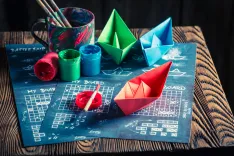Typing Games for Kids: Everything You Need to Know
Typing games help kids practice keyboard skills without feeling like drills. This guide covers fun activities that improve finger placement, accuracy, and speed while keeping learning light and motivating.

Typing games for kids to build accuracy and speed
In today’s digital world, the skill of fast and accurate typing is becoming an essential part of education and daily life. It’s no longer a luxury — it’s literally a foundation for mastering other subjects more easily, preparing for school, and completing hundreds of everyday tasks. What seems simple for an adult may appear confusing and difficult for a child. Even when a child learns to type, they don’t always do it correctly. And relearning is harder than learning from scratch.
For children, getting familiar with the keyboard can be both engaging and beneficial — especially with typing games for kids. These games not only entertain but also help develop motor skills, concentration, and confidence when using a computer.
In this article, we’ll explore the best typing games for different age groups, from toddlers to early elementary students, and show how they can become powerful tools for learning and development.
Why Are Typing Games Important for Children?
Typing games are not just tools for mechanically pressing buttons or memorizing letter positions on the keyboard. They represent a full-fledged new skill, which also involves training memory, attention, and reflexes. As children play, they improve:
- fine motor skills and hand-eye coordination
- concentration and focus
- typing speed and accuracy
- readiness for academic and professional tasks requiring typing skills
- confidence when using technology
Research shows that children who play educational games demonstrate improved cognitive abilities and perform better on tasks requiring attention and memory.

Help your child
grow with Keiki
We’ll help you turn everyday screen time
into real learning progress.
Best Typing Games for Toddlers (Ages 2–3)
For the youngest learners, it’s important to choose games that introduce basic keyboard concepts in a playful way. This isn’t about full-speed typing yet — kids at this age are just starting to learn the alphabet and letters. That’s why it’s crucial for the content to be well-rounded and balanced. Here are some popular options:
- Keyboard Climber 2. A monkey jumps up the cliffs when the child presses the correct keys. The game has no timer, which allows kids to learn at their own pace.
- Tux Typing. A penguin named Tux catches fish when the child presses the right keys. The game offers various difficulty levels and supports multiple languages.
- ABCya Keyboard Challenge. A fun educational game for learning typing, where kids help a robot navigate a maze by pressing the correct letters. Colorful graphics and a rewards system make learning enjoyable, while the absence of pressure creates a comfortable experience for toddlers.
- TypeTastic! for Kindergarten. A specially adapted version of TypeTastic! for the youngest users. It introduces children to the keyboard through simple mini-games: letter hunts, color-based key pressing, and pattern repetition. Everything is presented as cartoon-style scenes with rewards for every correct move.
These typing games for toddlers help children become familiar with key placement and develop fine motor skills.
Engaging Typing Games for Preschoolers (Ages 3–4)
Preschool-aged children are ready for more advanced challenges, and the following games help them develop their typing skills:
- Dance Mat Typing. Developed by the BBC, this game teaches kids correct finger placement on the keyboard through fun animations and songs.
- TypingClub. Offers structured lessons with gamification, making learning both enjoyable and effective.
These educational typing games improve accuracy and typing speed, as well as enhance concentration and focus. Additionally, Keiki includes activities that not only teach typing but also strengthen knowledge of the alphabet, individual letters, and their combinations. Only a comprehensive approach gives the best results, where typing is combined with practicing language, writing, and reading skills at the same time.
Fun Typing Games for Early Elementary School Kids (Ages 5–6)
For early elementary school children, games that combine learning with a competitive element are ideal:
- Nitro Type. Online races where car speed depends on typing speed. The game motivates kids to improve their skills in order to win races.
- TypeRacer. Players compete in typing speed by entering texts from popular movies, books, and songs. The game helps develop both speed and accuracy.
These typing games for elementary school kids turn typing practice into an exciting and motivating process. Keiki includes games for children aged 5–6 who are either preparing for school or already attending the early grades. At this age, when kids can already read and write, content should be more complex and in-depth, with a focus on writing practice and typing speed.

Tips for Parents: How to Help Your Child Learn to Type
Learning to type takes time, patience, and regular practice. Here are a few tips to help parents support their child along the way.
A calm environment is best for learning
Create a distraction-free space. Set up a comfortable area with an appropriate desk, chair, and keyboard. Remove background noise, TV, and unnecessary gadgets.
No rush
Start slow and build confidence gradually. Don’t expect quick results. Let your child get used to the keyboard one key at a time, at their own pace. It’s better to practice for 10–15 minutes a day consistently than to try to do everything at once.
Learn through play
Use games instead of pressure. Children learn better through fun. Instead of insisting on lessons, offer enjoyable typing games for kids online featuring favorite characters and animations. This lowers stress and increases motivation. That’s exactly the principle practiced in Keiki.
Praise matters
Praise effort, not just results. Encourage your child for trying and making progress, even if it’s small. Constant comparisons or demanding “perfect typing” can ruin motivation.
Show practical value for better motivation
Explain how useful typing can be. Show them why this skill matters — writing to friends, doing homework, searching for fun content online, or using educational apps.
Use multisensory reinforcement
Combine typing with other activities — for example, drawing the keyboard by hand, using flashcards with letters, or playing alphabet songs. This is another feature of Keiki: every task engages at least two skills. For instance, tracing letters or numbers not only teaches the alphabet and counting but also improves hand control, precision, and fine motor skills.
Stay involved and learn together
Be a learning partner: try playing a typing game yourself, talk about what was fun, set up mini challenges, or offer small rewards for progress.
Always remember, every child learns at their own pace. With your support, typing becomes not a chore, but a fun discovery of new possibilities.
Build real skills through fun, educational games for your child
Try KeikiHow to Integrate Typing Games into Daily Learning
To make the most of online typing games, early development experts and educators recommend:
- dedicating 10–15 minutes daily to typing games
- combining games with other educational resources like Keiki
- tracking your child’s progress and celebrating achievements
- discussing what the child learned and how it applies in real life
Integrating typing games for kids online into daily learning makes acquiring typing skills natural and enjoyable.
Typing games are an effective and engaging way to build typing skills in kids. They make learning fun, motivate children to reach goals, and prepare them for successful use of technology in the future. Integrating these games with educational platforms like Keiki provides comprehensive development for children in the digital age.
Download Keiki and start building future-ready skills with your child today.





